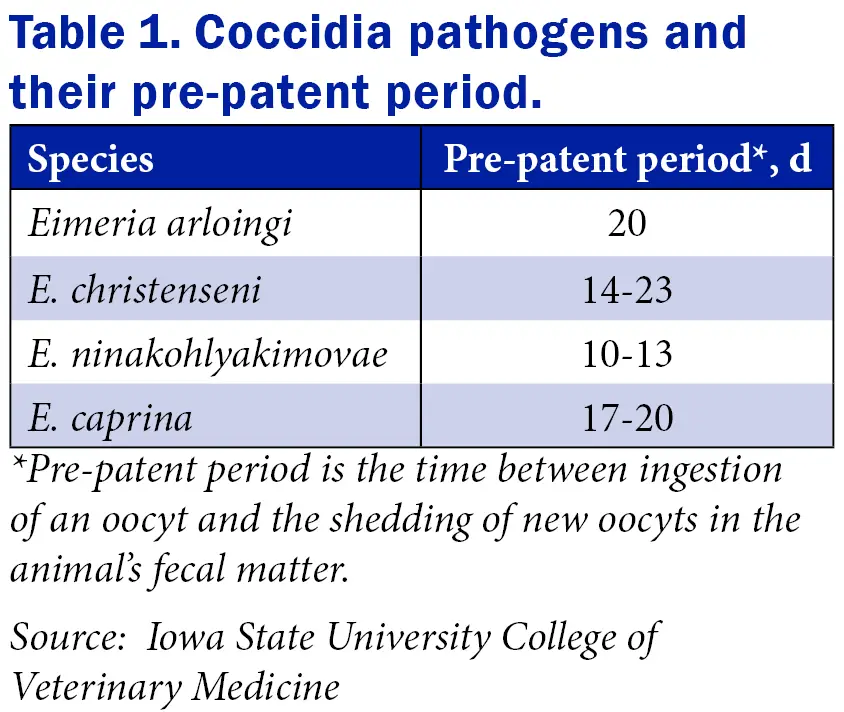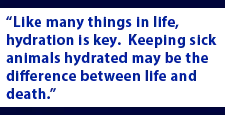
Detection, treatment and prevention of coccidia
 By Sarah Adamson
By Sarah Adamson
For many of us, spring means a new beginning with flowers sprouting, trees budding, and crops being planted. However, it also means an increased prevalence of bacteria, such as coccidia.
While any number of factors can cause diarrhea and scours, coccidia becomes the more likely cause when goat kids are between 3 weeks and 5 months of age. Coccidiosis is caused by microscopic protozoan parasites that invade the gastrointestinal (GI) tract. Since nearly all full-grown goats carry coccidia in their intestines and release coccidia eggs, or oocysts, in their feces, it’s almost impossible to completely eliminate coccidia from the environment. This means it is best to understand the impact coccidia have on your herd and then develop a herd-specific treatment and prevention plan.
How does coccidia spread?
Once the host animal releases the oocysts in its feces, the oocysts start a stage of development known as sporulation. Sporulation must be completed in a warm, moist and oxygen-rich environment before a new host can be infected. It can take between two and three days to complete, but, once sporulation is complete, the oocysts can persist in almost all environmental conditions and become resistant to most disinfectants.
 Other animals become infected by ingesting the oocysts via grazing or consuming hay, grain, or water that may have been contaminated by infected feces. Once inside the new host, it can take between 10 and 23 days for coccidia to complete its lifecycle and be shed in fecal samples. Table one shows how this lifecycle can vary depending on the host species. It is important to keep these pre-patent periods in mind because it is possible to have a clean fecal sample from an infected and symptomatic animal if the coccidia haven’t completed their lifecycle yet.
Other animals become infected by ingesting the oocysts via grazing or consuming hay, grain, or water that may have been contaminated by infected feces. Once inside the new host, it can take between 10 and 23 days for coccidia to complete its lifecycle and be shed in fecal samples. Table one shows how this lifecycle can vary depending on the host species. It is important to keep these pre-patent periods in mind because it is possible to have a clean fecal sample from an infected and symptomatic animal if the coccidia haven’t completed their lifecycle yet.
Coccidia can cause greater health issues the longer they are left untreated. Once inside the host, coccidia penetrate the intestinal lining of the host and destroy a large quantity of intestinal cells. This cell destruction causes the bloody diarrhea, or dark/tarry look, you see from infected animals.
This intestinal cell destruction causes an extensive amount of irreversible scarring and damage to the intestinal lining. Damaged intestines prevent animals from properly absorbing nutrients in their diet, which may result in permanently frail and stunted goats.
Prevent with good management
Luckily, with good management practices, we can slow the spread and impact coccidia can have on your farm. Some best practices include:
- Feed high-quality colostrum or colostrum replacer. This is important to help achieve an adequate passive transfer to help fight coccidia.
- Clean water buckets and feeders on a regular basis. Place grain feeders and water buckets outside of pens to minimize manure contamination and keep livestock from standing in them.
- Provide clean, dry and adequate bedding. Remember, coccidia and many gram-negative bacteria, thrive in wet and dirty environments. Along with proper stocking density, maintaining clean and dry bedding is crucial to prevent coccidiosis. Having enough dry and clean bedding for the kid to “nest” in is also important.
- Provide fresh air and airflow while avoiding major drafts. Also, if possible, allow sunshine to enter the barns.
Treatment and prevention
Various products can be incorporated into your farm’s nutrition program to help prevent the negative health implications of coccidia infections. Always consult with your veterinarian and nutritionist before introducing a treatment strategy on your farm. Some proven coccidia treatments include:
- Monensin (Rumensin®) – Monensin is an ionophore, which will only kill coccidia before they enter the intestinal cell, meaning ionophores don’t eliminate the threat of coccidia and need to be fed consistently to be effective. Underdosing is a concern if feed intakes are low, particularly in preweaned kids, or, if the coccidia load is especially high, other treatment options may need to be considered. Toxicity can also occur, and potentially cause death, so it is important to avoid mixing errors.
- Decoquinate (Deccox®) – Decoquinate is similar to an ionophore in that it only stops the growth of coccidia in its early life stages. It does have a lower toxicity compared to ionophores, but should be fed consistently to get the best results.
- Amprolium (Corid®) – Corid can be used as a very effective treatment or as a part of a prevention program. Overdosing is possible and can result in polioencephalomalacia. Signs of polioencephalomalacia include staring at the wall or ceiling, pushing their head against wall, and overall weakness. Polioencephalomalacia is treatable with thiamine. Please talk to your veterinarian for a specific feeding plan.
 Hydration – Like many things in life, hydration is key. Keeping sick animals hydrated may be the difference between life and death. Oral electrolytes are great if animals are healthy enough to suckle. Administer IV fluids if the animal can’t stand or suckle. A word of caution: Do not administer Banamine® to dehydrated animals because it has been linked to kidney failure.
Hydration – Like many things in life, hydration is key. Keeping sick animals hydrated may be the difference between life and death. Oral electrolytes are great if animals are healthy enough to suckle. Administer IV fluids if the animal can’t stand or suckle. A word of caution: Do not administer Banamine® to dehydrated animals because it has been linked to kidney failure.
By combining good management practices with early detection, we can help prevent any long-term health implications from coccidia infections. Talk with your veterinarian and nutritionist to put together an effective coccidia prevention plan.
About the author: Sarah Adamson grew up on her family’s commercial dairy goat farm in southern Wisconsin. She attended the University of Wisconsin-Platteville and received her bachelor’s degree in animal science, with an emphasis on dairy science. Adamson spent time as a manager on an 8,000-head dairy goat farm before joining Vita Plus in 2018. As the Vita Plus dairy goat specialist, Adamson is responsible for product development for the entire dairy goat program as well as technical support for field staff in the Vita Plus market area.
| Category: |
Animal health Dairy Goat Performance Feed additives |

